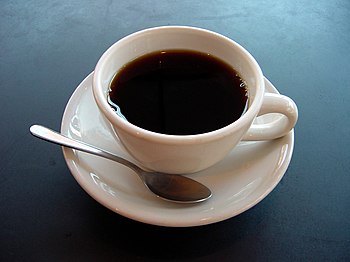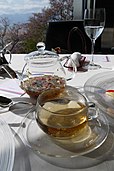Portal:Drink
The Drink Portal
A portal dedicated to all beverages
Introduction

A drink or beverage is a liquid intended for human consumption. In addition to their basic function of satisfying thirst, drinks play important roles in human culture. Common types of drinks include plain drinking water, milk, juice, smoothies and soft drinks. Traditionally warm beverages include coffee, tea, and hot chocolate. Caffeinated drinks that contain the stimulant caffeine have a long history.
In addition, alcoholic drinks such as wine, beer, and liquor, which contain the drug ethanol, have been part of human culture for more than 8,000 years. Non-alcoholic drinks often signify drinks that would normally contain alcohol, such as beer, wine and cocktails, but are made with a sufficiently low concentration of alcohol by volume. The category includes drinks that have undergone an alcohol removal process such as non-alcoholic beers and de-alcoholized wines. (Full article...)
Selected article -
The term "herbal" tea is often used to distinguish these beverages from true teas (e.g., black, green, white, yellow, oolong), which are prepared from the cured leaves of the tea plant, Camellia sinensis. Unlike true teas, most tisanes do not naturally contain caffeine (though tea can be decaffeinated, processed to remove caffeine). A number of plants, however, do contain caffeine or another stimulant, like theobromine, cocaine or ephedrine. Some have the opposite effect, acting as a sedative. Some common infusions have specific names such as mate (yerba mate) and rooibos (red bush). Hibiscus tea is one type of herbal infusion, but many described as some other plant have hibiscus as the main ingredient, or a major one. (Full article...)
Did you know? -
- ... that Maxine North swore never to return to Thailand after the death of her undercover CIA husband, but ultimately settled there and introduced bottled water to the country?
- ... that Assyrian Christian couples drink dust from the tombs of martyrs and are crowned during their weddings?
- ... that salt marsh snakes drink only rainwater?
- ... that Ben Phillips replaced his friend's hair gel with superglue, put Viagra in his sports drink, and placed him on a lake while he slept on an inflatable mattress?
- ... that in 1776 Abraham Hunt entertained Hessian mercenaries with food and drink to render them incapable for duty the night before George Washington defeated them at Trenton?
- ... that the "Mayor of Picklesburgh" is decided by a pickle juice drinking competition?
General images -
Selected image -

Selected biography -

Selected quote -
| “ | Beer is proof that God loves us and wants us to be happy. | ” |
| — Benjamin Franklin |
Selected ingredient -
The first documented use of hops in beer is from the 9th century, though Hildegard of Bingen, 300 years later, is often cited as the earliest documented source. Before this period, brewers used a "gruit", composed of a wide variety of bitter herbs and flowers, including dandelion, burdock root, marigold, horehound (the old German name for horehound, Berghopfen, means "mountain hops"), ground ivy, and heather. Early documents include mention of a hop garden in the will of Charlemagne's father, Pepin the Short.
Hops are also used in brewing for their antibacterial effect over less desirable microorganisms and for purported benefits including balancing the sweetness of the malt with bitterness and a variety of flavours and aromas. It is believed that traditional herb combinations for beers were abandoned after it was noticed that beers made with hops were less prone to spoilage.Topics
| General topics: | Bartending • Bottling • Drinking • Drinking water • Bottled water • Mineral water • Coffee • Energy drink • Juice • Tea • Milk • Plant milk • Pasteurization • Refrigeration • Steeping • Water purification |
| Alcoholic beverages: | Beer • Brandy • Brewing • Caffeinated alcoholic drinks • Cider • Cocktails • Distillation • Fermentation • Hard soda • Liquor • Liqueur • Malt drink • Mead • Proof • Rice Wine • Schnapps • Vodka • Whiskey • Wine |
| Soft Drinks: | Carbonation • Cola • Orange soft drink • Frozen carbonated drink • Root beer • Soda water • Lithia water • |
| Miscellaneous: | Drink industry • Lemonade • Limeade • Orange drink • Slush (beverage) |
List articles
Subcategories
Related portals
WikiProjects


WikiProject Food & Drink is an association of Wikipedians with an interest in culinary-related subjects. They have come together to co-ordinate the development of food and drink articles here on Wikipedia as well as the many subjects related to food such as foodservice, catering and restaurants. If you wish to learn more about these subjects as well as get involved, please visit the project.
 WikiProject Beer – covers Wikipedia's coverage of beer and breweries and microbreweries
WikiProject Beer – covers Wikipedia's coverage of beer and breweries and microbreweries
![]() WikiProject Wine – aims to compile thorough and accurate information on different vineyards, wineries and varieties of wines, including but not limited to their qualities, origins, and uses.
WikiProject Wine – aims to compile thorough and accurate information on different vineyards, wineries and varieties of wines, including but not limited to their qualities, origins, and uses.
| Child projects: | Task forces: (All inactive) |
| Related projects: | |
Things you can do
 |
Here are some tasks awaiting attention:
|
Associated Wikimedia
The following Wikimedia Foundation sister projects provide more on this subject:
-
Commons
Free media repository -
Wikibooks
Free textbooks and manuals -
Wikidata
Free knowledge base -
Wikinews
Free-content news -
Wikiquote
Collection of quotations -
Wikisource
Free-content library -
Wikiversity
Free learning tools -
Wiktionary
Dictionary and thesaurus




































































